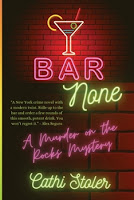by Erica Miner
‘San Francisco, a city that considers its Opera only slightly less sacred than the Holy Grail’
San Francisco. City by the Bay. Famous for stunning landmarks: the Golden Gate Bridge, Alcatraz, Pier 39, Fisherman’s Wharf. Legendary for its cable cars, iconic waterfront, steep rolling hills and Victorian architecture. A city of contrasts, from its natural beauty to its technology. Of fascinating history, from the gold rush to the present.
But the San Francisco of Overture to Murder, the latest novel in my Julia Kogan Opera Mystery series, is a city of mystery: Twin Peaks, stealthy fog…and the ghostly upper reaches of its opera house.
After her
life-threatening entanglements in murder investigations at the Metropolitan
Opera (Aria for Murder) and Santa Fe Opera (Prelude to Murder),
intrepid young violinist Julia Kogan takes on new challenges as the
concertmaster (first of the first violinists) of the San Francisco Opera, a
position of immense responsibility. She is temporarily replacing the current
concertmaster, who has been badly injured in a hit-and-run accident, which
Julia thinks worthy of looking into as not accidental. It is a high-pressure
situation for her, both musically and emotionally, but she’s up to the test—or
is she?
In the
historical War Memorial Opera House, Julia finds a theatre steeped in history:
among other things, it’s adjacent to the Veterans Building where Harry Truman
signed the UN Charter in 1945. But she also finds intrigue. There’s no time for
sampling the sourdough, Dim Sum, Ghirardelli chocolates and other culinary
delights of the city. Julia has her work cut out for her, trying to uncover the
perpetrator in the latest grisly operatic killing.
The city of San
Francisco and its opera are in my blood. I have a personal connection with both
of them. Over the last several decades I paid numerous visits to this amazing
city to spend time with a close family member who worked with the company and
with other family members and friends who lived in the Bay Area. Thus I
experienced a doubly significant journey when I recently toured the War
Memorial Opera House with the House Head, who had been working there for over
30 years and knew every corner and cranny. Little had I known that the place,
which had served as the locale for the film Foul Play, is filled with
creaky old equipment that’s positively scary to look at and listen to and is
home to its own ghosts.
As I cringed
from these discoveries, I put myself in Julia’s shoes. How does she cope with
disturbingly creative modes of murder devised by a mentally unhinged killer?
She investigates, of course, as is her wont. Her natural curiosity gets the
better of her, as it has in previous opera houses. She will leave no sheet of
music unturned until she discovers the perpetrator’s identity, with little
regard for her own safety. The trouble is, she’s not the only one who’s in
danger. The life of another person near and dear to her is in jeopardy as well.
The tables have turned.
It was such a trip for me in so many ways to write this novel. Nostalgia about my past experiences with the company met with the fascination I experienced in my forays at the opera house of the present. Julia is my alter ego, based on myself when I, too, was an eager young violinist. But I could never summon up the level of courage that becomes essential for her as she navigates the perilous world of opera mystery in the dark stairways, back hallways, and hundred foot-high catwalks of the War Memorial Opera House. And again, the curtain comes down on murder.
About Erica:
Former Metropolitan Opera violinist Erica Miner is now an award-winning author, screenwriter, arts journalist, and lecturer based in the Pacific Northwest. Her debut novel, Travels with My Lovers, won the Fiction Prize in the Direct from the Author Book Awards. Her current Julia Kogan Opera Mystery series reveal the dark side of the fascinating world of opera: Aria for Murder (Level Best Books, 2022), was a finalist in the 2023 Eric Hoffer and Murder and Mayhem Awards; Prelude to Murder (2023) a Distinguished Favorite in the 2024 NYC Big Book Awards, glowingly reviewed by Kirkus Reviews; and the just-released Overture to Murder (2024). As a writer-lecturer, Erica has given workshops for Sisters in Crime; Los Angeles Creative Writing Conference; EPIC Group Writers; Write on the Sound; Fields End Writer’s Community; Savvy Authors; and numerous libraries on the west coast.
ISBN-10:
978-1-68512-781-7 (pb)
ISBN-13:978-1-68512-782-4
(eb)
Webpage: www.ericaminer.com
Social media:
https://www.facebook.com/erica.miner1
https://twitter.com/EmwrtrErica
https://www.instagram.com/emwriter3/
Buy Link: Amazon
Blurbs:
“Anyone who loves the romance of opera and opera houses will enjoy
Overture to Murder. Miner gives us a unique tour of the War Memorial Opera
House, letting us in on its secrets, legends and gossip, and one of its
most important occupants, the San Francisco Opera. She shares many details only
a true insider can know, bringing the building to life and making it an
essential character in this exceptionally well-crafted mystery.” ~ John
Boatwright, San Francisco Opera House Head
“Divas and deadly secrets share center stage in Erica Miner’s Overture
to Murder, a classic mystery tale set at the San Francisco Opera House,
a chilling backdrop for murder. Precise details, inside information about the
glamorous world of classical music, and a cast of finely drawn characters
propel the action from the opening curtain to the final bows. This suspenseful
tale of mystery, music, and mayhem is a page-turner. Highly recommend.” ~ Lori
Robbins, author of the On Pointe Mysteries
“Set against the elegant backdrop of the San Francisco Opera, this smart, suspenseful mystery weaves a tale as intricate and compelling as Wagner's Ring. With its masterful blend of suspense, music, and drama, OVERTURE TO MURDER is a must-read for mystery enthusiasts and opera lovers alike. Mally Becker, Agatha Award-nominated author of The Revolutionary War mysteries.


.png)

.jpg)





.jpg)
.jpg)
.jpg)

















